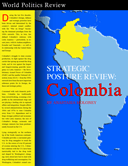During the last five decades, Colombia's foreign, defense and strategic priorities have been driven and determined by the country's internal armed conflict, with the "War on Drugs" becoming the dominant paradigm from the 1980s onwards. This, in turn, has defined Colombia's relations with Latin America -- particularly, in recent years, with its Andean neighbors, Ecuador and Venezuela -- as well as its relationship with the United States and Europe.
Colombia's struggle to stem cocaine production, its fight against the drug cartels that sprung up around the drug trade, and its war against the largest and longest-running guerrilla insurgency in Latin America -- the Revolutionary Armed Forces of Colombia (FARC) and the smaller National Liberation Army (ELN) -- from the 1960s onwards have been the most important reference points for its foreign, defense and strategic policy.
Consumed with such domestic problems, Colombia has traditionally been inward-looking, assuming a low profile on the international stage and not playing a leading role in regional affairs and integration. Despite efforts by several administrations during the 1960s and 1970s to steer Colombia away from U.S. dependence and to forge stronger political and economic ties with Latin America, the axis of Colombia's foreign, economic and strategic interests has been predominantly focused on the U.S.

